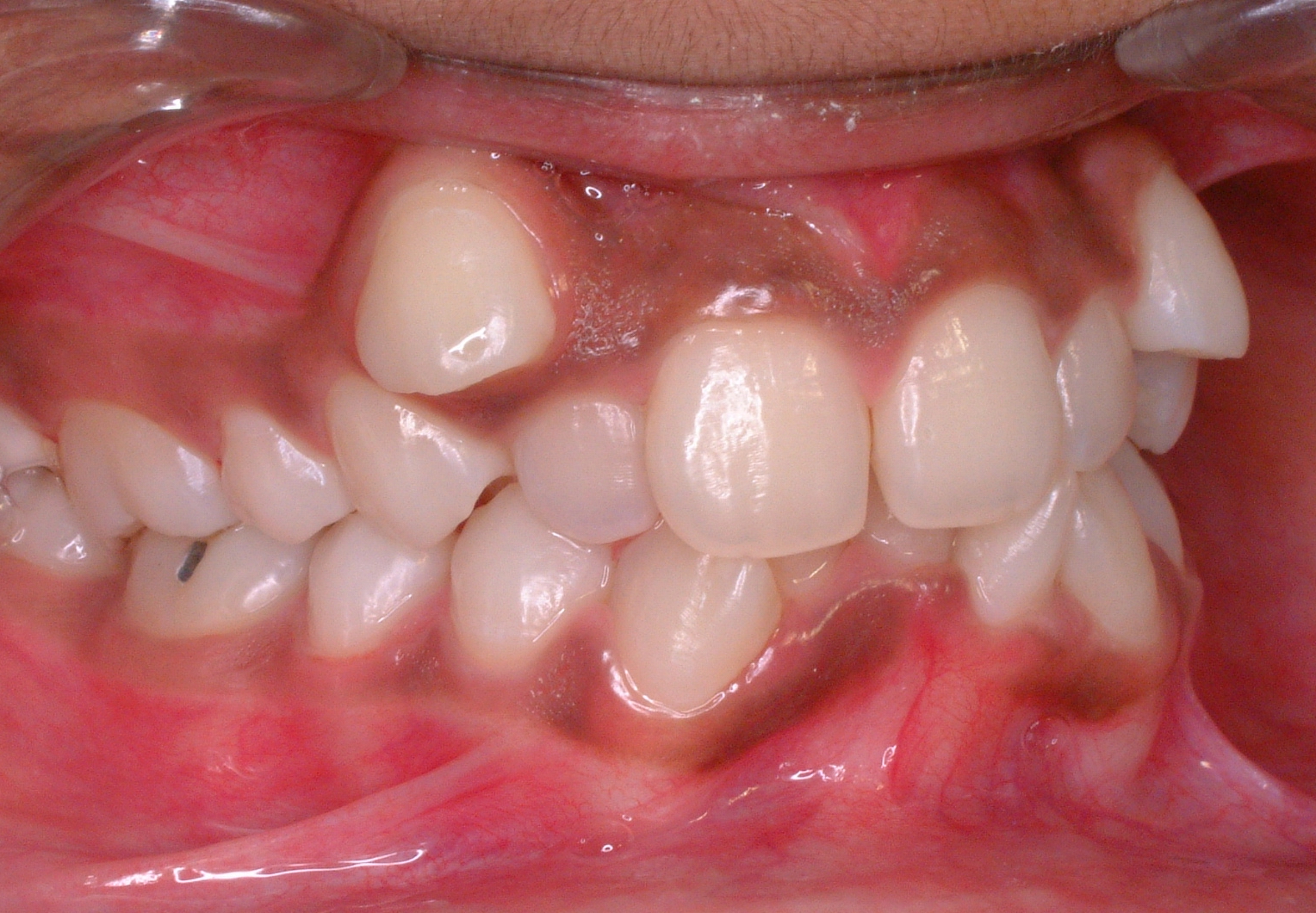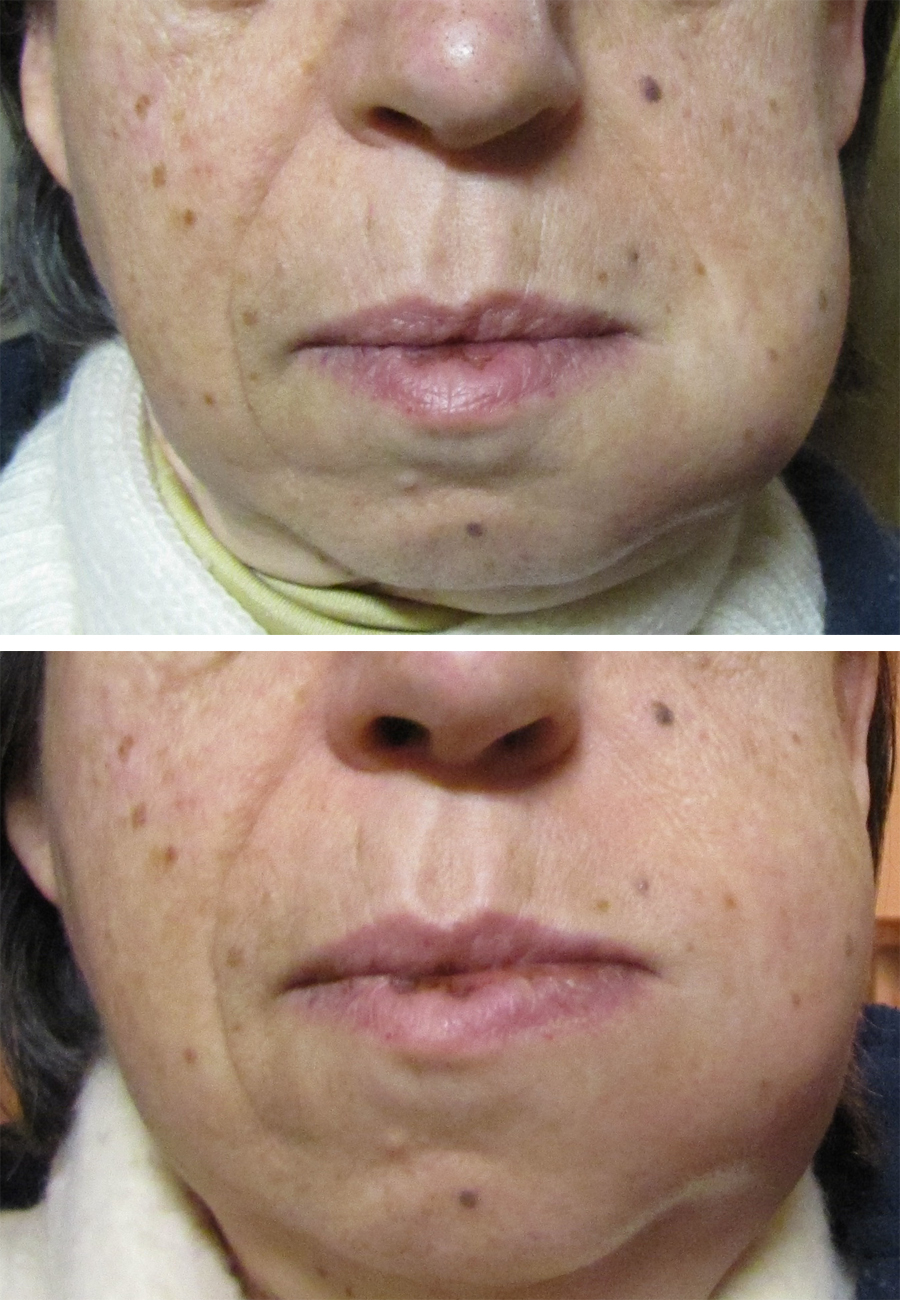|
Malocclusion
In orthodontics, a malocclusion is a misalignment or incorrect relation between the teeth of the upper and lower dental arches when they approach each other as the jaws close. The English-language term dates from 1864; Edward Angle (1855–1930), the "father of modern orthodontics", popularised it. The word derives . The malocclusion classification is based on the relationship of the mesiobuccal cusp of the maxillary first molar and the buccal groove of the mandibular first molar. If this molar relationship exists, then the teeth can align into normal occlusion. According to Angle, malocclusion is any deviation of the occlusion from the ideal. However, assessment for malocclusion should also take into account aesthetics and the impact on functionality. If these aspects are acceptable to the patient despite meeting the formal definition of malocclusion, then treatment may not be necessary. It is estimated that nearly 30% of the population have malocclusions that are cat ... [...More Info...] [...Related Items...] OR: [Wikipedia] [Google] [Baidu] |
Overjet
In dentistry, overjet is the extent of horizontal ( anterior-posterior) overlap of the maxillary central incisors over the mandibular central incisors. In class II (division I) malocclusion the overjet is increased as the maxillary central incisors are protruded. Class II Division I is an incisal classification of malocclusion where the incisal edge of the mandibular incisors lie posterior to the cingulum plateau of the maxillary incisors with normal or proclined maxillary incisors (British Standards Index, 1983). There is always an associated increase in overjet. In the Class II Division 2 incisal classification of malocclusion, the lower incisors occlude posterior to the cingulum plateau of the upper incisors and the upper central incisors are retroclined. The overjet is usually minimal but it may be increased. Signs and symptoms Class II Div I :Benefits associated with orthodontic treatment include a reduction in the susceptibility to caries, periodontal disease and tempor ... [...More Info...] [...Related Items...] OR: [Wikipedia] [Google] [Baidu] |
Orthodontics
Orthodontics (also referred to as orthodontia) is a dentistry specialty that addresses the diagnosis, prevention, management, and correction of mal-positioned teeth and jaws, as well as misaligned bite patterns. It may also address the modification of facial growth, known as dentofacial orthopedics. Abnormal alignment of the teeth and jaws is very common. The approximate worldwide prevalence of malocclusion was as high as 56%. However, conclusive evidence-based medicine, scientific evidence for the Health benefit (medicine), health benefits of orthodontic treatment is lacking, although patients with completed treatment have reported a higher quality of life than that of untreated patients undergoing orthodontic treatment. The main reason for the prevalence of these malocclusions is diets with less fresh fruit and vegetables and overall softer foods in childhood, causing smaller jaws with less room for the teeth to erupt. Treatment may require several months to a few years and enta ... [...More Info...] [...Related Items...] OR: [Wikipedia] [Google] [Baidu] |
Tongue Thrusting
Tongue thrust, also called reverse swallow or immature swallow, is a pseudo-pathological name for an adaptive lip seal mechanism, whereby normal nasal breathing or normal swallowing can occur. Tongue thrust can also be seen as an oral myofunctional disorder, a tongue muscle pattern that is perceived as clinically abnormal, in which the tongue protrudes anteriorly to seal the otherwise incompetent lips. Tongue thrusting is seen during speech, swallowing or eating, and in order to close otherwise incompetent lips and anterior open bite. In normal suckling behavior, infants have their tongues positioned between their gum pads anteriorly resting on the lower lip, which facilitates infantile (i.e. visceral) swallowing pattern. As teeth start to erupt and solid foods are introduced, pharyngeal muscles, posterior tongue, and elevator muscles of the lower jaw play a role in the swallowing pattern. As the child's primary molars erupt, swallowing follows a somatic pattern characterized b ... [...More Info...] [...Related Items...] OR: [Wikipedia] [Google] [Baidu] |
Edward Angle
Edward Hartley Angle (June 1, 1855 – August 11, 1930) was an American dentist, widely regarded as "the father of American orthodontics". He was trained as a dentist, but made orthodontics his speciality and dedicated his life to standardizing the teaching and practice of orthodontics. He founded the Angle School of Orthodontia in 1899 in St. Louis and schools in other regions of the United States. As the originator of the profession, Angle founded three orthodontic schools between 1905 and 1928 in St. Louis, Missouri, New London, Connecticut and Pasadena, California. These exclusive institutions provided the opportunity for several pioneering American orthodontists to receive their training. Life He was born to Philip Casebeer Angle and Isabel Erskine Angle in Herricks, New York. He was fifth of the seven children. During his childhood years he demonstrated early talent of working with tools and machinery including hay rake. He attended high school in Canton, Pennsylvani ... [...More Info...] [...Related Items...] OR: [Wikipedia] [Google] [Baidu] |
Occlusion (dentistry)
Occlusion, in a dental context, means simply the contact between teeth. More technically, it is the relationship between the maxillary (upper) and mandibular (lower) teeth when they approach each other, as occurs during chewing or at rest. Static occlusion refers to contact between teeth when the jaw is closed and stationary, while dynamic occlusion refers to occlusal contacts made when the jaw is moving. The masticatory system also involves the periodontium, the TMJ (and other skeletal components) and the neuromusculature, therefore the tooth contacts should not be looked at in isolation, but in relation to the overall masticatory system. Anatomy of Masticatory System One cannot fully understand occlusion without an in depth understanding of the anatomy including that of the teeth, TMJ, musculature surrounding this and the skeletal components. The Dentition and Surrounding Structures The human dentition consists of 32 permanent teeth and these are distributed between ... [...More Info...] [...Related Items...] OR: [Wikipedia] [Google] [Baidu] |
Orthognathic Surgery
Orthognathic surgery (), also known as corrective jaw surgery or simply jaw surgery, is surgery designed to correct conditions of the jaw and lower face related to structure, growth, airway issues including sleep apnea, TMJ disorders, malocclusion problems primarily arising from skeletal disharmonies, and other orthodontic dental bite problems that cannot be treated easily with braces, as well as the broad range of facial imbalances, disharmonies, asymmetries, and malproportions where correction may be considered to improve facial aesthetics and self-esteem. The origins of orthognathic surgery belong in oral surgery, and the basic operations related to the surgical removal of impacted or displaced teeth – especially where indicated by orthodontics to enhance dental treatments of malocclusion and dental crowding. One of the first published cases of orthognathic surgery was the one from Dr. Simon P. Hullihen in 1849. Originally coined by Harold Hargis, it was more widely popul ... [...More Info...] [...Related Items...] OR: [Wikipedia] [Google] [Baidu] |
Dental Caries
Tooth decay, also known as caries,The word 'caries' is a mass noun, and is not a plural of 'carie'.'' is the breakdown of teeth due to acids produced by bacteria. The resulting cavities may be a number of different colors, from yellow to black. Symptoms may include pain and difficulty eating. Complications may include periodontal disease, inflammation of the tissue around the tooth, tooth loss and infection or dental abscess, abscess formation. Tooth regeneration is an ongoing Stem-cell therapy, stem cell–based field of study that aims to find methods to reverse the effects of decay; current methods are based on easing symptoms. The cause of cavities is acid from bacteria dissolving the hard tissues of the teeth (Tooth enamel, enamel, dentin and cementum). The acid is produced by the bacteria when they break down food debris or sugar on the tooth surface. Simple sugars in food are these bacteria's primary energy source and thus a diet high in simple sugar is a risk factor. I ... [...More Info...] [...Related Items...] OR: [Wikipedia] [Google] [Baidu] |
Deglutition
Swallowing, also called deglutition or inglutition in scientific and medical contexts, is a physical process of an animal's digestive tract (e.g. that of a human body) that allows for an ingested substance (typically food) to pass from the mouth to the pharynx and then into the esophagus. In colloquial English, the term "swallowing" is also used to describe the action of ''gulping'', i.e. taking in a large mouthful of food without any biting. Swallowing is performed by an initial push from back part of the tongue (with the tongue tip contacting the hard palate for mechanical anchorage) and subsequent coordinated contractions of the pharyngeal muscles. The portion of food, drink and/or other material (e.g. mucus, secretions and medications) that moves into the gullet in one swallow is called a bolus, which is then propelled through to the stomach for further digestion by autonomic peristalsis of the esophagus. Swallowing is an important part of eating and drinking. If the proce ... [...More Info...] [...Related Items...] OR: [Wikipedia] [Google] [Baidu] |
Otitis Media
Otitis media is a group of Inflammation, inflammatory diseases of the middle ear. One of the two main types is acute otitis media (AOM), an infection of rapid onset that usually presents with ear pain. In young children this may result in pulling at the ear, increased crying, and poor sleep. Decreased eating and a fever may also be present. The other main type is otitis media with effusion (OME), typically not associated with symptoms, although occasionally a feeling of fullness is described; it is defined as the presence of non-infectious fluid in the middle ear which may persist for weeks or months often after an episode of acute otitis media. Chronic suppurative otitis media (CSOM) is middle ear inflammation that results in a perforated tympanic membrane with discharge from the ear for more than six weeks. It may be a complication of acute otitis media. Pain is rarely present. All three types of otitis media may be associated with hearing loss. If children with hearing los ... [...More Info...] [...Related Items...] OR: [Wikipedia] [Google] [Baidu] |
Craniofacial Abnormality
Craniofacial abnormalities are congenital musculoskeletal disorders which primarily affect the cranium and facial bones. They are associated with the development of the pharyngeal arches. Approximately, 5% of the UK or USA population present with dentofacial deformities requiring Orthognathic surgery, jaw surgery, and Orthodontics, brace therapy, as a part of their definitive treatment. Notable conditions * Platybasia * Arrhinia - absence of the nose * Craniosynostosis - premature fusion of the cranial sutures * Cyclopia Cyclopia (named after the Greek mythology characters cyclopes), also known as alobar holoprosencephaly, is the most extreme form of holoprosencephaly and is a congenital disorder (birth defect) characterized by the failure of the embryonic prosen ... - one eye * Mobius syndrome - paralysis of the facial muscles References External links Congenital disorders of musculoskeletal system {{musculoskeletal-stub ... [...More Info...] [...Related Items...] OR: [Wikipedia] [Google] [Baidu] |
Periapical Abscess
A dental abscess is a localized collection of pus associated with a tooth. The most common type of dental abscess is a periapical abscess, and the second most common is a periodontal abscess. In a periapical abscess, usually the origin is a bacterial infection that has accumulated in the soft, often dead, pulp of the tooth. This can be caused by tooth decay, broken teeth or extensive periodontal disease (or combinations of these factors). A failed root canal treatment may also create a similar abscess. A dental abscess is a type of odontogenic infection, although commonly the latter term is applied to an infection which has spread outside the local region around the causative tooth. Classification The main types of dental abscess are: * Periapical abscess: The result of a chronic, localized infection located at the tip, or apex, of the root of a tooth. * Periodontal abscess: begins in a periodontal pocket (see: periodontal abscess) * Gingival abscess: involving only t ... [...More Info...] [...Related Items...] OR: [Wikipedia] [Google] [Baidu] |






